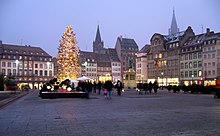Place Kléber
This articleneeds additional citations forverification.(December 2018) |




ThePlace Kléber(KleberplatzinGerman) is the central square ofStrasbourg,France.As the largest square at the center of Strasbourg, in the heart of the city's commercial area, it was named after French revolutionary generalJean-Baptiste Kléber,born in Strasbourg in 1753. In the square is a statue of Kléber, under which is a vault containing his remains. On the north side of the square is theAubette(Orderly Room), built byBlondelin 1765–1772.
Located in Strasbourg's historic center, theGrande Île( "Large Island" ), the area was classified aWorld Heritage SitebyUNESCOin 1988, the first time such an honor was placed on an entire city center.[1]
History[edit]
The first name of the Place Kléber wasBarfüsserplatz('Square of the Barefoot Nuns' inGerman) because aFranciscanmonastery was standing along the square). In the 17th century, the name changed toWaffenplatz('Arms Square' in German). On 24 June 1840, the square was finally renamed for the French general Jean-Baptiste Kléber, also going by 'Kléberplatz' after German annexation.
During German occupation in 1940–1944, the place was renamed after Karl Roos, a local ethnically German politician executed by French authorities in 1940 on the charges of espionage for Germany.
The Aubette[edit]
TheAubettewas built in 1765–1772 byJacques François Blondel,architect to KingLouis XV of France.
In 2006, after a long and careful restoration, the inner decoration of the Aubette, made in the 1920s byHans Arp,Theo van Doesburg,andSophie Taeuber-Arpand destroyed in the 1930s, was made accessible to the public again. The work of the three artists had been called "theSistine Chapelofabstract art".
The statue of Kléber[edit]
After his assassination in 1800 inCairo,the body of Jean-Baptiste Kléber, general during theFrench Revolutionary Wars,born in Strasbourg in 1753, was repatriated to France.Napoleon,fearing that his tomb would become a symbol toRepublicanism,ordered it to stay at theChâteau d'If,on an island nearMarseille.It stayed there for 18 years untilLouis XVIIIgranted him a burial place in his hometown in Strasbourg. He was buried on 15 December 1838 below his statue located in the middle of the Place Kléber. His heart is in an urn in the caveau of the Governors beneath the altar of the St. John Chapel inLes Invalides,Paris.
The statue, designed byPhilippe Grass,was finally completed in 1838.
The Christmas tree[edit]
Traditionally, a huge fir tree (30 m) coming from theVosges mountainsis erected every year on the south west of the Place Kléber and inhabitants deposited gifts for the poor. During theChristkindelsmärik(Christmas market), the booths of 50 charitable associations make the Village du Partage ( "Village for Sharing" ).
References[edit]
- ^"Strasbourg, Grande-Île and Neustadt".UNESCO World Heritage Centre.United Nations Educational, Scientific, and Cultural Organization.Retrieved17 October2021.
